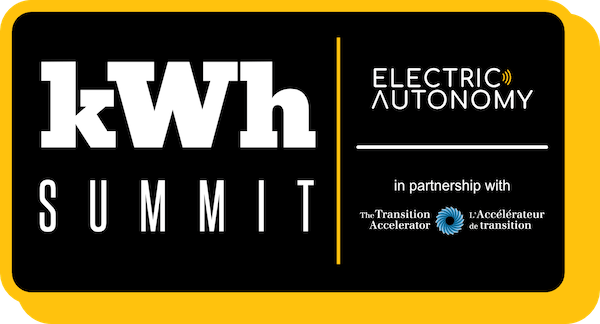Fleet electrification has a power problem. A new report from Dunsky and Clean Energy Canada explores regulatory reforms needed to scale fleet decarbonization

Grid reforms are needed to support fleet decarbonization says Dunsky Energy + Climate Advisors senior consultant, Maddy Ewing.
Fleet electrification has a power problem. A new report from Dunsky and Clean Energy Canada explores regulatory reforms needed to scale fleet decarbonization
As more fleets across Canada and the U.S. electrify, securing sufficient power to support depot charging is increasingly difficult.
Electricity demand rises quickly when electrifying medium- and heavy-duty vehicles (MHDVs) and a recent NACFE survey found utility coordination and upgrade lead times are major barriers to fleet electrification.
Fleet operators often lack visibility into what to expect.
As a result, most fleets are scaling (electric vehicle) EV deployments according to the power available on site. This approach, however, cannot be sustained long-term as it will not allow fleets to electrify at scale, nor at the pace that is otherwise economically optimal (let alone what is required to reach national decarbonization targets).
Yet, solutions exist to ensure timely and affordable service upgrades for MHDV fleets.
Proactive grid planning, fair cost-sharing, and smarter energy rates are key to accelerating MHDV electrification. With supportive policy and regulatory alignment, these steps can drive meaningful emissions reductions and deliver public benefits without burdening ratepayers.
Proactive grid investments
To reduce or eliminate lead times, utilities must shift how they approach load forecasting and grid upgrade efforts by proactively investing in areas where MHDV electrification is expected to occur.
Currently, most utilities plan grid upgrades using load forecasts that haven’t historically accounted for MHDV electrification.
Maddy Ewing will be discussing best practices to speed up grid connections for charging sites and fleets at the kWh Summit

The event takes place on May 13, 2025 in Toronto. Join us.
Unlike light-duty EVs, MHDV loads are large and highly localized — one fleet can trigger major upgrades.
The complexity of supplying additional electricity to a MHDV depot site depends on the proximity and capacity of nearby distribution infrastructure.
If local feeders and substations can handle the load, upgrades may be minor, but if they can’t, costly and time-consuming work — like new feeders or substation upgrades — may be required.
Yet utilities often lack visibility into where fleets exist or are electrifying and rarely forecast at the feeder level, where these impacts are felt.
As a result, critical infrastructure to support MHDV electrification is often overlooked and forces reactive service upgrades, which are slow and costly, rather than benefiting from proactive planning and investment.
While it’s challenging to anticipate exactly where these loads will materialize, there are steps utilities can take to deepen their understanding, like customer surveys, geospatial analyses, or assigning key account managers who conduct proactive outreach.
Cost sharing
On the cost front, current policies often saddle first movers with most costs associated with upstream capacity increases. This is a deterrent for fleets to electrify.
Utilities should build the case for ratebasing these investments, allowing costs to be shared among all ratepayers — justified by the broader benefits they bring.
While some worry about rising rates, Dunsky analysis over the years suggests that programs and upgrades that support beneficial electrification can result in net benefits for the ratepayer (other analysis reaches similar conclusions). Service upgrades that enable electrification also improve air quality, reduce emissions, and can benefit future property owners and nearby customers.
Smarter electricity pricing
Importantly, there are also steps utilities can take to incentivize electricity use during off-peak periods, thereby reducing the need for upgrades to the distribution system. This includes developing electricity rates that reflect real-time grid conditions (including capacity on the distribution grid) and demand-side management programs like managed charging or vehicle-to-grid.
These three reforms — proactive investments in the grid, ratebasing infrastructure upgrades that support MHDV electrification, and smarter electricity pricing — will all take time to implement and will necessitate significant regulatory proceedings.
Thankfully, there are steps fleets and utilities alike can take to cost-effectively supply power to sites in the short-term while regulatory changes are evolving.
Short-term solutions
Fleets can start by optimizing charging schedules to reduce peak demand.
Where upgrades are unavoidable, interim solutions — such as temporary construction services, portable chargers, or relying on public chargers — can help bridge the gap.
Utilities should work proactively to ensure they are ready for this transition and do not become a bottleneck. (For instance, utilities like ENMAX and Toronto Hydro publish heatmaps that showcase remaining capacity across their territories. These maps don’t eliminate the need for upgrades when infrastructure falls short, but they do give stakeholders more visibility.)
Likewise, fleets can work with trade organizations to collectively call for utility regulatory reforms that can help ensure beneficial electrification of MHDVs.
While near-term workarounds can ease current challenges, long-term reforms are essential.
Dunsky Energy + Climate Advisors explored this topic in more depth in a recent report for Clean Energy Canada, Costs of and Bottlenecks in Zero-Emission Medium- and Heavy-Duty Vehicle Infrastructure Deployment.

Maddy Ewing is a Senior Consultant at Dunsky Energy + Climate Advisors.






